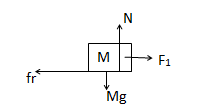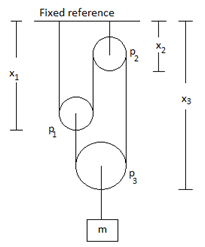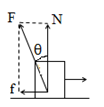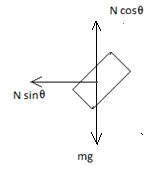12th Grade > Physics
NEWTON S LAWS WITH FRICTION AND BEYOND MCQs
Total Questions : 13
| Page 1 of 2 pages
Question 1. A civil engineer wishes to redesign the curved roadway in such a way that a car will not have to rely on friction to round the curve without skidding. In other words, a car moving at the designated speed can negotiate the curve even when the road is covered with ice. Such a ramp is usually banked, which means that the roadway is tilted toward the inside of the curve. Suppose the designated speed for the ramp is to be 10.0 m/s and the radius of the curve is 20.0 m. At what angle should the curve be banked?
Answer: Option C. -> Mg ≤ F ≤ Mg √1+μ2
:
C

If F1 = 0
So contact force will only have Normal which is equal to Mg
So F will be Mg
Now as F1 increasesfrkeeps increasing till it reaches limiting value i.e., μN = μmg
So, in that case, contact force F will be
√N2+fr2 =√(Mg)2+(μMg)2
F = Mg√1+μ2
This means contact force F will lie between Mg≤ F≤ Mg√1+μ2
:
C

If F1 = 0
So contact force will only have Normal which is equal to Mg
So F will be Mg
Now as F1 increasesfrkeeps increasing till it reaches limiting value i.e., μN = μmg
So, in that case, contact force F will be
√N2+fr2 =√(Mg)2+(μMg)2
F = Mg√1+μ2
This means contact force F will lie between Mg≤ F≤ Mg√1+μ2
Answer: Option A. -> ap1 = 2ap3
:
A

∴ x1+ x1- x2+ x3- x2+x3-x1= L
L is length of string.
⇒x1- 2x2+ 2x3= L
Assuming mass 'm' moves downward
P1will move up. Which means distance from P1and reference point will reduce.
∴d2x1dt2=−a(p1)
Differentiating twice
∴ ⇒- a1- 0 + 2a3= 0 (x2is constant)
⇒2a3=a1
⇒ 2a(p3) = a(p1)
:
A
∴ x1+ x1- x2+ x3- x2+x3-x1= L
L is length of string.
⇒x1- 2x2+ 2x3= L
Assuming mass 'm' moves downward
P1will move up. Which means distance from P1and reference point will reduce.
∴d2x1dt2=−a(p1)
Differentiating twice
∴ ⇒- a1- 0 + 2a3= 0 (x2is constant)
⇒2a3=a1
⇒ 2a(p3) = a(p1)
Question 4. Spring fitted doors close by themselves when released. You want to keep the door open for a long time, say for an hour. If you put a half kg stone in front of the open door, it does not help. The stone slides with the door and the door gets closed. However, if you sandwich a 20 gm piece of wood in the small gap between the door and the floor, the door stays open. Explain why a much lighter piece of wood is able to keep the door open while the heavy stone fails. Assume coefficient of friction between stone and ground and wood and ground are the same.
Answer: Option C. -> Limiting friction will increase as the horizontal force on the block by the ground will increase
:
C
In this case, the door will apply a downward force on the wooden piece which will increase the normal force that the ground applies on the wooden piece. ∴ Limiting value of friction will increase.
:
C
In this case, the door will apply a downward force on the wooden piece which will increase the normal force that the ground applies on the wooden piece. ∴ Limiting value of friction will increase.
Answer: Option A. -> → (Rightwards)
:
A
Block A moves in the leftward direction with respect to B. ∴ Friction will act in the rightward direction on A. As the bonds formed will oppose the relative motion.
:
A
Block A moves in the leftward direction with respect to B. ∴ Friction will act in the rightward direction on A. As the bonds formed will oppose the relative motion.
Answer: Option C. -> 50N, 40N
:
C
When static,
fmax = μs x N
= 0.5 ×mg
= 0.5 ×10 ×10
= 50N
∴ Minimum value of external force required to move it is 50 N
When moving
F = μk ×N
= 0.4 ×10 ×10
= 40N
∴ When moving, minimum force required prevent it from accelerating/decelerating is 40N.
:
C
When static,
fmax = μs x N
= 0.5 ×mg
= 0.5 ×10 ×10
= 50N
∴ Minimum value of external force required to move it is 50 N
When moving
F = μk ×N
= 0.4 ×10 ×10
= 40N
∴ When moving, minimum force required prevent it from accelerating/decelerating is 40N.
Answer: Option A. -> 37∘, 5N
:
A
Let the contact force on the block by the surface be F which makes an angle θwith the vertical

The component of F perpendicular to the contact surface is the normal reaction N and the component of F parallel to the surface is the well-known frictional force f. As the surface is horizontal, N is vertically upward. For vertical equilibrium,
N = mg = (0.400 kg) 10ms2 = 4.0 N.
The frictional force is f = 3.0 N.
(a)
Or, θ = tan−1( 34) = 37∘.
(b)The magnitude of the contact force is
F =√N2+f2
=√(4.0N)2+(3.0N)2 = 5.0 N.
:
A
Let the contact force on the block by the surface be F which makes an angle θwith the vertical
The component of F perpendicular to the contact surface is the normal reaction N and the component of F parallel to the surface is the well-known frictional force f. As the surface is horizontal, N is vertically upward. For vertical equilibrium,
N = mg = (0.400 kg) 10ms2 = 4.0 N.
The frictional force is f = 3.0 N.
(a)
Or, θ = tan−1( 34) = 37∘.
(b)The magnitude of the contact force is
F =√N2+f2
=√(4.0N)2+(3.0N)2 = 5.0 N.
Answer: Option A. -> 40 N
:
B
As the external force F is gradually increased from zero it is compensated by the friction and the string bears no tension. When limiting friction is achieved by increasing force F to a value tillμsmg, the further increase in F is transferred to the string.

When[F<μsmg;The friction is static and T = 0F≥μsmg;T=F−μsmg]
:
B
As the external force F is gradually increased from zero it is compensated by the friction and the string bears no tension. When limiting friction is achieved by increasing force F to a value tillμsmg, the further increase in F is transferred to the string.
When[F<μsmg;The friction is static and T = 0F≥μsmg;T=F−μsmg]



















